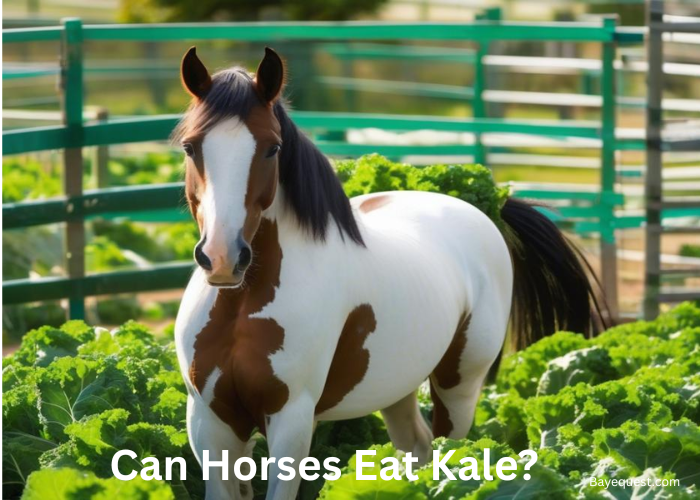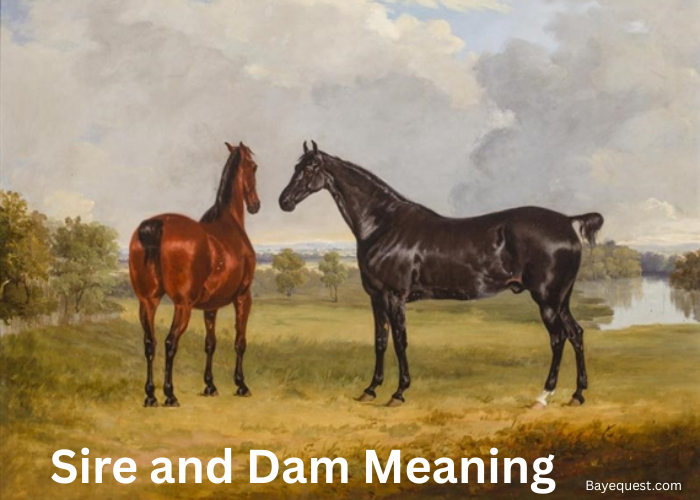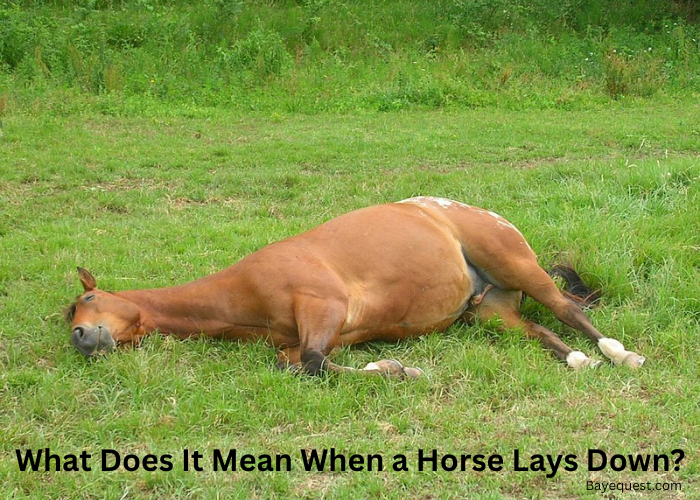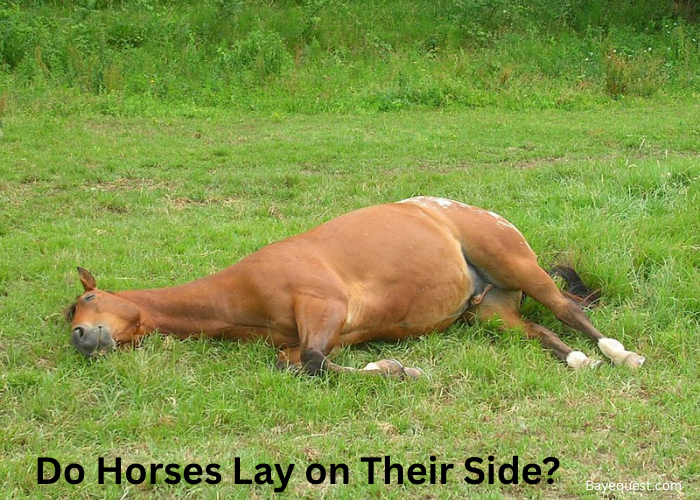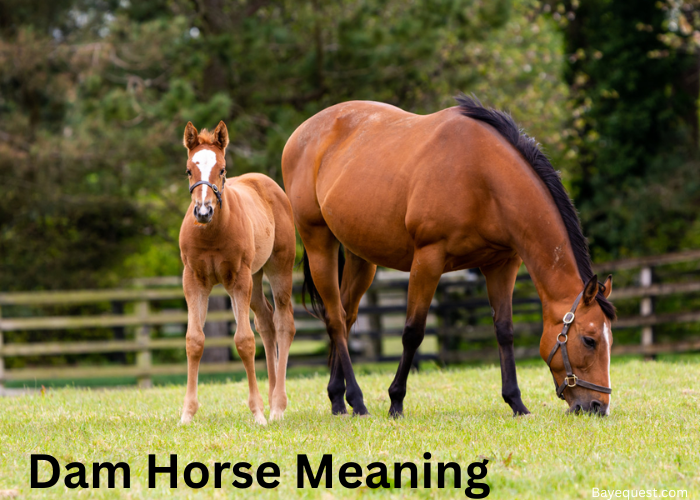Humans know kale as a “superfood.” The vegetable is rich in essential vitamins, minerals, and antioxidants that nourish the body and support overall health.
As a result, horse owners often wonder – can horses eat kale too? Is it a healthy equine treat or a hidden risk?
In this guide, we’ll look closely at what happens when horses eat kale. By the end, you’ll know its benefits, possible side effects, and how much is safe to feed your horses.
Can Horses Eat Kale? Key Takeaway
Yes, horses can eat kale, but only in small amounts. Though it isn’t toxic, kale contains oxalates and glucosinolates. These naturally occurring organic compounds can interfere with calcium absorption and thyroid function if fed too often. So, a few fresh, washed leaves once or twice a week are safe for most healthy horses.
Kale’s Nutritional Benefits in Horses
Kale is one of the most nutrient-rich greens. It’s packed with vitamins, minerals, and antioxidants that can support your horse’s overall health when given in small amounts.
One of its biggest strengths is vitamin A, which supports good vision, healthy skin, and a shiny coat.
Kale also provides vitamin C, which helps the immune system fight off infections. Then there’s vitamin K, known for its role in blood clotting and bone strength.
Minerals are another highlight. Kale contains calcium, potassium, and magnesium, all of which are essential for strong muscles and healthy bones.
However, because kale also contains oxalates, too much of it can stop the body from using calcium.
Kale is also rich in antioxidants, which help reduce inflammation and protect cells from damage. These compounds can be especially useful for performance horses or older horses that need extra immune support.
Another plus: kale is low in sugar and calories. This makes it a good choice for easy keepers or horses that gain weight easily. It provides nutrients without adding too many extra calories to their diet.
In a nutshell, when used correctly, kale can give your horse a valuable nutritional boost, especially during seasons when pasture quality is low.
Still, remember that kale is highly concentrated. A small amount offers plenty of nutrients. For this reason, more isn’t always better. Think of it as a supplement, not a staple.

Is Kale Safe for Horses?
Yes, kale, in moderate amounts, is safe for horses. It isn’t toxic. But, at the same time, it is not something your horse should eat every day.
Kale belongs to the Brassica family, the same group as cabbage, broccoli, and cauliflower. These vegetables are rich in nutrients. But they also contain compounds that can cause problems if eaten too often.
One concern is oxalates. These are natural chemicals found in many leafy greens. In large amounts, oxalates can bind to calcium in the body.
This makes it harder for your horse to properly absorb calcium, which may affect bone and muscle health over time.
Another issue is glucosinolates. Unfortunately, these sulfur-based compounds aren’t too friendly to the digestive system. When fed in excess, they can interfere with thyroid function and cause mineral imbalances.
That said, a few kale leaves won’t hurt a healthy horse. Most horses can safely enjoy kale as an occasional treat. The key is moderation. Kale should be part of a varied diet, not a regular part of the feed.
However, avoid kale altogether if your horse has kidney or thyroid issues. These horses are more sensitive to the minerals and compounds in brassicas.
Also, always start small. Offer just a handful of washed, fresh kale leaves and watch for any signs of bloating or discomfort.
If everything looks normal, you can give it once or twice a week as a crunchy, vitamin-rich snack.
Are Kale Stems Safe for Horses?
Yes, kale stems are safe for horses in small, manageable pieces. But, they’re tougher and more fibrous than the leaves, so it’s best to chop them to prevent choking.
Always make sure the stems are fresh and clean before feeding. Also, avoid giving large amounts, as too much fiber from stems can cause mild digestive discomfort.
Is Baby Kale Safer Than Mature Kale for Horses?
Yes, baby kale is generally safer than mature kale for horses. It contains lower levels of oxalates and glucosinolates, the compounds that can cause mineral and thyroid issues when overfed.
Baby kale is also softer, milder, and easier to digest. Still, it should only be given occasionally and in small portions.
Dangers of Feeding Kale to Horses: Potential Risks and Side Effects
Even healthy foods can cause trouble when fed the wrong way. Kale is no different. While it offers valuable nutrients, too much can upset your horse’s balance.
The following are the most common issues;
Weakened bones and muscles
When the oxalates in kale bind to calcium in the body, calcium becomes harder to absorb. Over time, this can weaken bones, teeth, and muscles.
In severe cases, high oxalate intake may even lead to kidney strain or the formation of calcium deposits.
Compromised thyroid function
In large amounts, glucosinolates can interfere with the thyroid gland. This may reduce hormone production, slow metabolism, and cause changes in weight or energy.
Therefore, horses with thyroid problems should avoid kale completely.
Digestive problems
Some horses are sensitive to brassica vegetables and may develop gas or bloating. Signs include a swollen belly, restlessness, or reduced appetite.
These symptoms usually appear within hours of overfeeding on kale.
Other/Higher risks
Horses with kidney disease, metabolic issues, or mineral imbalances should not eat kale at all. Their systems are already under strain, and the compounds in kale can make things worse.
If your horse ever shows signs of discomfort, stop feeding kale and contact your vet. It’s always better to be cautious, especially with foods outside a horse’s normal diet.

How to Feed Kale to Horses Safely
If you decide to give your horse kale, the key is to keep things simple. Here are general guidelines to avoid trouble.
Start by choosing fresh, clean kale – Avoid wilted, yellowed, or slimy leaves. Additionally, wash the kale thoroughly to remove dirt, bugs, or pesticide residue. Horses are sensitive to chemicals, so clean produce is a must.
Feed kale raw, not cooked – Cooking can destroy some of the nutrients, and seasoned or oiled kale is unsafe for horses. Just tear the fresh leaves into smaller pieces and mix them with your horse’s normal feed. Alternatively, offer them by hand as a crunchy treat.
How much should you give? – A small handful (about 3–5 leaves) is enough for most horses. You can offer it once or twice a week, but not every day. Remember, kale is a supplement — not a regular feed or forage replacement.
When introducing kale for the first time, go slow – Give only a small piece and watch how your horse reacts. If there’s no bloating, gas, or change in appetite, you can safely offer a bit more next time.
Always store kale properly – Keep it in the fridge, away from sunlight, and use it within a few days of purchase. Spoiled kale can ferment and upset your horse’s stomach.
If your horse doesn’t like kale, don’t force it – Some horses simply prefer other greens. You can rotate kale with safer options like romaine lettuce, turnip greens, or dandelion leaves for variety.
The goal is to offer a fresh, healthy nibble, not a new staple. A small, crisp serving of kale can be a fun way to add nutrients and texture to your horse’s diet.
Comparing Kale to Other Leafy Greens for Horses
Fortunately, kale isn’t the only green that horses can eat. Many owners also offer spinach, lettuce, or cabbage.
But, since not all greens are equal when it comes to safety and nutrition, you must pick the alternatives wisely. The following comparisons should help you choose the best treat for your horse.
Kale vs spinach
Spinach has a similar nutrient profile. Rich in vitamins A and C, but it also contains high levels of oxalates. That means it poses the same calcium-binding risks as kale, or even more.
Therefore, spinach should be given only rarely, in very small amounts.
Kale vs lettuce
Lettuce, especially romaine or leaf lettuce, is much milder. It contains less oxalate and is easier on the stomach. It’s also high in water, which can help keep your horse hydrated.
However, lettuce is less nutrient-dense than kale. It’s safe but offers fewer vitamins and minerals.
Kale vs cabbage
Both kale and cabbage belong to the Brassica family. Consequently, cabbage can cause gas and bloating if overfed, sometimes more than kale.
Still, small portions of cabbage are generally safe. It’s best to offer it sparingly, just like kale.
Kale vs dandelion greens
Dandelion leaves are one of the best natural treats for horses. They’re full of vitamins A and K, low in oxalates, and even act as a gentle liver cleanser. Thus, they’re safer for regular feeding than kale.
In summary, kale is more nutrient-packed than most greens but carries higher risks if overfed. For everyday feeding, milder options like lettuce or dandelion leaves are a better choice.
The best solution, though, is to rotate your greens. Give kale one week, lettuce the next, and dandelion leaves after that.
This way, your horse enjoys different flavors and nutrients without overloading on one type.

What Other Vegetables Should Horses Not Eat?
The vegetables horses should never eat include onions, garlic, potatoes, or tomatoes. These belong to the nightshade family and can be toxic, causing digestive problems, anemia, or even organ damage.
Avocados are also unsafe because they contain persin, a compound harmful to horses. It can cause serious problems like respiratory distress, colic, irregular heartbeat, and swelling around the head or chest.
Other cruciferous vegetables, such as cabbage, broccoli, and cauliflower, should be limited. They can cause gas, bloating, and discomfort when fed in large amounts.
Above all, always introduce new foods slowly and check with your vet before adding any unfamiliar vegetables to your horse’s diet.
FAQs
Can pregnant mares eat kale?
It’s best not to feed kale to pregnant mares. Kale contains compounds like oxalates and glucosinolates that can interfere with calcium and iodine absorption, which are vital for the mare and developing foal. Even small imbalances can affect bone and thyroid health during pregnancy. Stick to safer greens and consult your vet before trying anything new.
Can kale help horses gain weight?
No, kale won’t help horses gain weight. It’s very low in calories and mainly provides vitamins, minerals, and antioxidants rather than energy or fat. While it can boost nutrition, it doesn’t supply enough calories to support weight gain. For that, horses need higher-energy feeds like alfalfa, beet pulp, or healthy oils.
What’s the best way to store kale for horses?
The best way to store kale for horses is to keep it in the refrigerator. Place the leaves in a plastic bag or container with small air holes to maintain freshness. It should stay crisp for about five days. Always check for wilted, slimy, or discolored leaves before feeding, and discard any that look spoiled.
Can miniature horses or ponies eat kale?
Yes, miniature horses and ponies can eat kale, but only in very small portions. Because of their smaller size, even a few leaves are enough. Too much kale can upset their mineral balance or cause digestive issues more quickly than in larger horses. Always feed it sparingly and as an occasional treat.
Is kale safe for horses with metabolic issues?
No, kale isn’t recommended for horses with metabolic issues. It contains oxalates and glucosinolates, which can interfere with calcium and thyroid function. These compounds may also make it harder for the body to regulate minerals and hormones. It’s safer to avoid kale and stick to low-sugar, vet-approved feeds instead.
Conclusion
Kale can be a healthy treat for horses, but only in small amounts. It’s full of vitamins and minerals that support coat, bone, and immune health.
Still, its oxalates and glucosinolates mean it should never be fed in large or daily portions.
A few fresh leaves once or twice a week are plenty. Always wash the kale well, keep it raw, and watch for any signs of discomfort after feeding.




